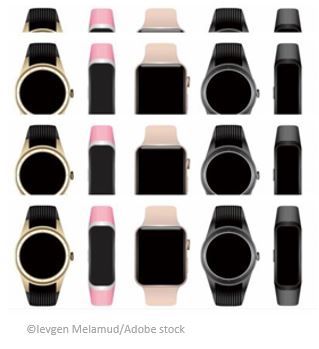- Clinical Technology
- Adult Immunization
- Hepatology
- Pediatric Immunization
- Screening
- Psychiatry
- Allergy
- Women's Health
- Cardiology
- Pediatrics
- Dermatology
- Endocrinology
- Pain Management
- Gastroenterology
- Infectious Disease
- Obesity Medicine
- Rheumatology
- Nephrology
- Neurology
- Pulmonology
Wrist-worn Devices Prove Cost-effective for AF Screening of 30 Million in Economic Simulation
Screening for atrial fibrillation with 6 wrist-worn wearable devices proved more cost effective than no screening and had greater relative benefit than using traditional modalities.

Screening for atrial fibrillation (AF) using wearable devices is cost-effective when compared to either no screening or AF screening using traditional methods, according to findings of an economic microsimulation just published in JAMA Health Forum.
The cost-effectiveness was durable across multiple clinically relevant scenarios, according to the authors, including screening a general population aged 50 years or older with risk factors for stroke as well as those of ages younger than currently recommended by clinical guidelines.
“In general, our findings support previous observations suggesting that AF screening can be cost-effective, and they provide new evidence that strategies using wearable devices may be economically favorable,” wrote lead author Jagpreet Chhatwal, PhD, director of the Massachusetts General Hospital Institute for Technology Assessment and assistant professor at Harvard Medical School.
Studies of conventional AF screening strategies to date have used single time-point screening, limiting potential detection of paroxysmal AF, write Chhatawal and colleagues. Wrist-worn wearable devices that are now available to screen for AF allow repeated screening and greater sampling density over longer periods, increasing the likelihood of detecting less frequent episodes of arrhythmia. However, they point out, longer screening duration may increase costs as well as potential harm associated with downstream testing and false positives, the study authors write. Moreover, the actual cost effectiveness of the wearable devices is unknown.
Wrist-worn wearable devices that are now available to screen for AF allow repeated screening and greater sampling density over longer periods, increasing the likelihood of detecting less frequent episodes of arrhythmia...but longer screening duration may increase costs as well as potential harm associated with downstream testing and false positives.
Citing this gap in understanding of the economics, conflicting endorsements among clinical guidelines for AF screening, and the logistical constraints of conducting randomized clinical trials comparing the wide range of existing screening strategies, Chhatawal et al developed a simulation model able to flexibly compare AF screening with both traditional ECG-based and wrist-worn wearable modalities.
The study compared the cost-effectiveness of 8 AF screening strategies with no screening. Of these strategies, 6 used wrist-worn wearable devices (watch or band photoplethysmography [PPG], with or without watch or band electrocardiography [ECG]) and 2 used traditional modalities (pulse palpation and 12-lead ECG.
The economic evaluation used a microsimulation decision-analytic model and was performed from September 2020 - May 2022. The model simulated a 30-million-person cohort matched on age and comorbidity distribution with the 2019 US population aged ≥65 years old, the age at which clinical guidelines recommend screening for AF.
To estimate the association of screening with clinical outcomes, the team used population-based estimates of event rates and treatment effects in addition to the test characteristics of the modalities being studied; uncertainty was accounted for in model estimates, they write.
For each simulated screening strategy, the investigators calculated total quality-adjusted life-years (QALYs) and total costs, as well as incremental cost-effectiveness ratios (ICERs). The secondary measures included rates of stroke and major bleeding.
FINDINGS
In the base case analysis, the mean age was reported as 72.5 years and 50% of the simulated individuals were women.
Chhatawal et al report that all 6 AF screening strategies using wrist-worn wearable devices were estimated to be more effective compared to no screening (range of QALYs gained, 226 - 957 per 100 000 individuals). The wrist worn devices were also associated with greater relative benefit than screening using traditional modalities (−116 to 93 QALYs gained per 100 000 persons).
Importantly the investigators found the wrist-worn wearables associated with a reduction in incidence of stroke by 20 – 23 events per 100 000 person years but also with an increase major bleeding by 20 to 44 events per 100 000 person-years.
Importantly the investigators found the wrist-worn wearables associated with a reduction in incidence of stroke by 20 – 23 events per 100 000 person years but also with an increase major bleeding by 20 to 44 events per 100 000 person-years.
The overall cost-effective screening strategy, the data show, was wrist-worn PPG followed conditionally by wearable 1-lead ECG with patch monitor confirmation. The incremental cost-effectiveness ratio was $57 894 per QALY, meeting the acceptability threshold of $100 000 per QALY.
“Wearable screening remained cost-effective across strata of sex and substantial variations in wearable device–related costs and mean daily wear time,” the authors write. Cost effectiveness was also consistent with variation in the association of anticoagulation with risk of stroke in the setting of screening-detected AF.
“Our results provide justification for the potential use of wrist-worn wearable devices integrated into composite AF screening pathways,” the authors conclude in part. They add: “Randomized clinical trials are warranted to better quantify potential benefits of AF screening using wearable devices, and our findings may be useful to inform the design of such trials to optimize clinical and economic efficiency.”
Reference: Chen W, Khurshid S, Singer DE, et al. Cost-effectiveness of screening for atrial fibrillation using wearable devices. JAMA Health Forum. 2022;3(8):e222419. doi:10.1001/jamahealthforum.2022.2419
